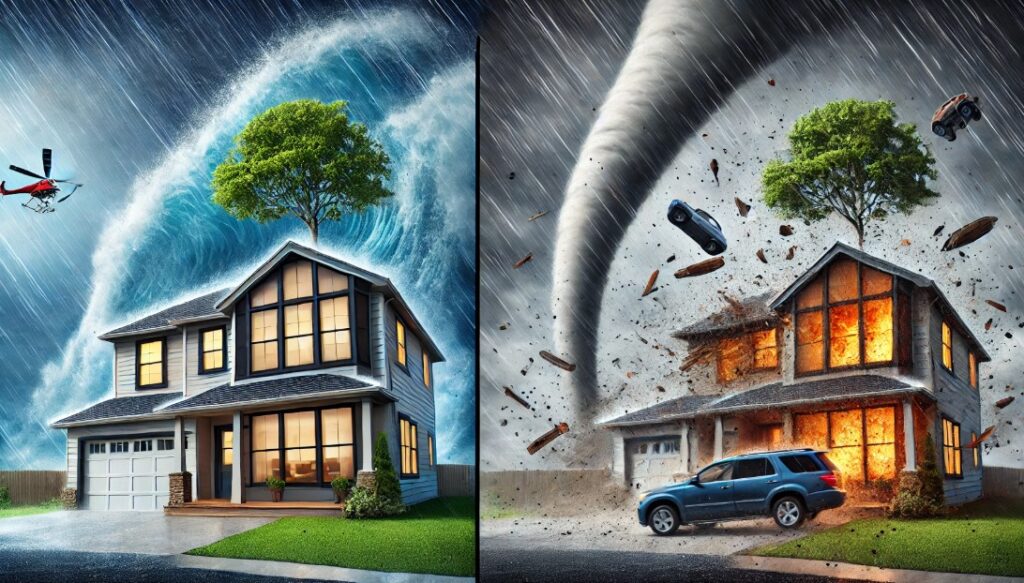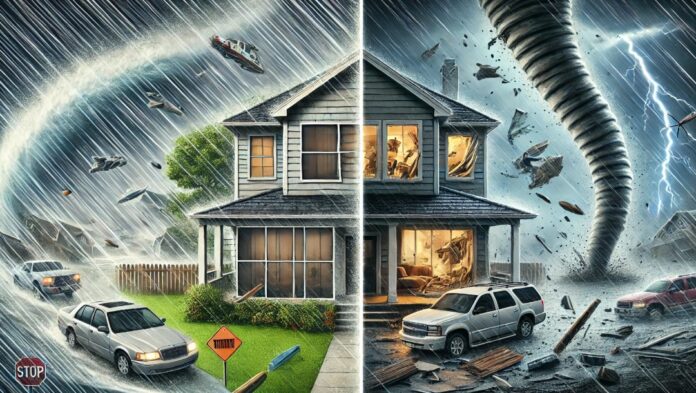Hurricane screens were created with a specific purpose in mind – to protect windows from getting shattered by debris during tornado setups. Even with that in mind, there are still questions such as, ‘Will hurricane screens protect windows from tornadoes?’ In the upcoming sections, we will understand the potential use of these hurricane screens in tornado prone areas by looking at their functions and limitations.
What Are Hurricane Screens?
Hurricane screens are made of lightweight, flexible, and high yielding substances, which allow them to withstand a lot of pressure without getting damaged. Materials like Kevlar or high strength polypropylene are perfect candidates. Their design allows them to be mounted directly on the window where they act like a shield and protect the house from the torrential winds and flying debris during a hurricane and also rust proof, which makes them perfect for use in coastal areas that are easily affected by storms.
Tornadoes vs. Hurricanes: A Key Difference in Forces

Hurricanes and tornadoes differ from each other in a number of different ways, which ordering to understand whether hurricane screens would be effective in shielding windows from tornados, we need to first take a look at the different forces they exert.
- Wind Speeds:
- The minimum velocity for hurricanes are usually at 74 mph, and in category 5 storms the maximum goes over 157 mph.
- The maximum force winds are able to reach during a tornado normally exceed 200 mile per hour, with the average tornado winds exceeding 200 mph for ef4 and ef5 tornadoes.
- Flying Debris:
- Tornadoes can lift and throw fragments of buildings, automobile, utility wires and poles as well as trees, while hurricanes can only manage tiny bits of debris such as tree branches and shingles shingles.
- Pressure Changes:
- Windows of buildings can get destroyed and other structures of the building can get compromised due to the intense air pressure changes caused by Tornadoes.
Are Hurricane Screens Tornado-Resistant?
While hurricane screens provide substantial protection during hurricanes, their effectiveness in a tornado scenario has limitations. Here’s why:
- Material Strength: The material of hurricane screens can resist impacts from tiny debris and at a certain velocity, however, the strength is lacking against projectiles like those from tornadoes.
- Wind Rating: Hurricane screens may protect against the water and wind during hurricanes, but are rendered useless against the concentrated and severe wind of tornadoes.
- Structural Vulnerabilities: Even with screens, the rapid pressure fluctuations and wind forces of a tornado can damage window frames and structures.
How Hurricane Screens Perform in Tornado-Prone Areas
Even if hurricane screens are not meant for tornadoes, they would serve some purpose in weaker tornadoes (EF0-EF2). Higher EF-grade tornadoes tend to be stronger, hence additional protection measures would be needed. To achieve maximum protection:
- Impact Resistant Glass: Utilizing laminated impact-resistant glass windows alongside hurricane screens works as a winning combination as it provides more strength against heavy debris.
- Reinforced Frame Installations: The process of altering window frames helps the window assembly withstand strong pressure from wind and blows without breaking
- Impact Resistant Products: Using specific storm shutters or panels that have undergone testing and have an ASTM rating for tornados may offer better protection.
Complementary Solutions and Alternatives Tornado Protection
To better prepare for tornadoes, consider these measures alongside hurricane screens:
- Storm Shelters: The ideal way to stay safe during tornadoes is using safe rooms or storm shelters since they are built to sustain EF5 winds and debris.
- Plywood Boards: If properly installed and firmly anchored, plywood boards can serve as adequate protection in emergency scenarios.
- Shatterproof Films: Shatterproof films can be added onto windows to reduce the risk of injury that comes from broken glass.
- Tornado-Proof Shutters: These shutters serve the utilitarian purpose of offering added protection and are specially reinforced to withstand high-pressure scenarios such as tornadoes.
The Importance of Codes Regarding Tornados
Modern building codes including those of regions which encounter tornadoes typically expect a particular level of windows and doors durability within the building – extreme weather expects over time. For example:
- International Building Code (IBC): Many regions adopt the IBC to mandate wind-resistant features in construction.
- Enhanced Fujita Scale (EF): Building standards sometimes align with EF-scale ratings to ensure safety during specific tornado intensities.
Maintenance and Inspection of Hurricane Screens
For hurricane screens to function effectively, regular maintenance is crucial:
- Check for Damage: Inspect screens for tears, loose threads, or compromised fittings after each storm season.
- Ensure Proper Installation: Improperly installed screens can fail during high winds, reducing their effectiveness.
- Store Screens Correctly: When not in use, store hurricane screens in a dry, clean space to prevent material degradation.
FAQs
1. Can hurricane screens withstand tornado debris?
Hurricane screens are designed to withstand smaller, fast-moving debris typical of hurricanes. While they may offer some protection in weak tornadoes, they are not rated for large or heavy objects commonly propelled by EF3 to EF5 tornadoes.
2. What are the best window protections for tornadoes?
The combination of impact-resistant glass, tornado-rated shutters, and reinforced frames are the best options for windows that are highly susceptible to tornadoes. Pairing these with a safe room gives individuals comprehensive safety.
3. Do hurricane screens need additional support for tornadoes?
Yes, hurricane screens alone are not enough. Combining them with stronger structural reinforcements or tornado-rated products is recommended for better protection.
4. Are hurricane screens able to be reused after a tornado?
The ability of screens to be used after a tornado depends on the intensity of the tornado itself. If the screens are torn or have loose fittings, they would need to be replaced.
5. What areas are most at risk for tornadoes?
The U.S Midwest, Great Plains and the Southeast are all subject to tornadoes, but the majority are active in Tornado Alley.
Conclusion
Although hurricane shutters can act as a means of secondary barrier defense in windows, they are not designed to withstand tornado strikes. The forces during a tornado are far greater than any hurricane screen was designed to withstand. People living in tornado-prone regions should use a combination of hurricane screens, impact-resistant glass, screened in structures, and reinforced safe rooms.
The answer is yes, but only partially, if one was to ask on whether hurricane shutters can save windows during a tornado; while their primary purpose is to block hurricanes. Hence, try to use standard solutions that are ideal for tornado protection but as a secondary window protection, hurricane shutters will work – but to a certain degree, so expert leaves comparison analysis advice is to fully ensure safety, use those solutions that cater specifically for tornadoes and adhere to local safety policies to the letter.


